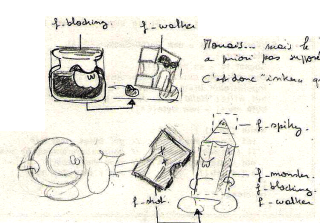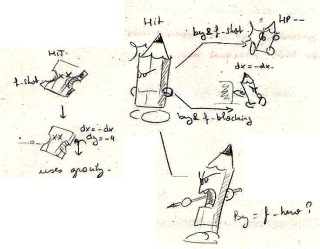 Les collisions, c'est probablement un des éléments les plus important de la gestion des sprites dans un moteur de jeu. Outre l'aspect purement technique "y a-t-il ou pas collision" et l'aspect d'optimisation "comment tester les collisions entre N sprites (potentiellement (N*N-1)/2 calculs) en un temps raisonnable", il y a le côté "logique du jeu": comment vont réagir les différents objets en cas de collision.
Les collisions, c'est probablement un des éléments les plus important de la gestion des sprites dans un moteur de jeu. Outre l'aspect purement technique "y a-t-il ou pas collision" et l'aspect d'optimisation "comment tester les collisions entre N sprites (potentiellement (N*N-1)/2 calculs) en un temps raisonnable", il y a le côté "logique du jeu": comment vont réagir les différents objets en cas de collision.
Mes premiers jeux étaient assez élémentaires de ce point de vue là: collision = touché sauf si ybilou+8<ymonster. une tentative un peu simpliste de simuler le "pogotage de cafetière à la SuperMario".
 Mais ça, c'était du temps du BASIC. En 1997 (déjà programmeur en assembleur et bricolant mon 'mod player à l'époque), je suis à l'unif le cours d'algorithmique de PaDM ou je découvre les joies des listes liées et où SJ me guide tout doucement vers la compréhension que "tes 'registres de sprites' ressemblent à des variables-membre en POO".
Mais ça, c'était du temps du BASIC. En 1997 (déjà programmeur en assembleur et bricolant mon 'mod player à l'époque), je suis à l'unif le cours d'algorithmique de PaDM ou je découvre les joies des listes liées et où SJ me guide tout doucement vers la compréhension que "tes 'registres de sprites' ressemblent à des variables-membre en POO".
Collisions play a major role in game engines. So far, in my former game attempts, i mostly focused on "how do we know there is a collision?" or "how can i support many sprites without slow-down due to O(N²) collisions detection effort?". This time, i'm rather focusing on "what shall we do once a collision is detected?". Collisions are event that will affect the state machine of our sprites... of both sprites that are involved in the collision. My first "serious" design effort on collisions management dates back from "Out'm'Up" game for the 100K-game competition at Inscene'2K (a demoparty in Belgium), the distilled wisdom resulting on my effort to build an "Ultimate Game Maker" between '97 and '99.
Rétrospectivement, ça fait un peu peur: après 10 ans de programmation, je n'avais pas encore terriblement évolué dans ma manière d'approcher les problèmes de quand je programmais mon "Calimero" en BASIC C64 à grand coup de Gotos. Seule grosse différence, je tentais de reproduire en Software (via des "registres" pour la position, la vitesse, la puissance, etc.) le hardware idéal pour mon moteur de jeu. Un variante non-déclarée de la machine virtuelle donc, mais qui me poussait à sur-définir des éléments tout à fait accessoire du genre "combien de bits pour le niveau d'attaque et le niveau de défense du sprite ?"
 |
| Out'm'Up, mon dernier shoot en date |
The core concept is that in a collision between two sprites, one is *active* and the other *passive*. I.e. the passive sprite has just registered itself in a list of "sprites that accept collisions", but the active sprite is the one who will scan that list for a match. Together with that mechanism comes the idea of *casts*. We only have a limited number of such "lists" where sprites can register -- one per sprite cast. And so far, in all games two casts seems to be enough: heroes and evils. In a laser-ufo collision, for instance, the UFO is passive evil and the laser is active. That means that the laser only checks UFOs for collisions, not other lasers or explosions, bonuses, etc. In the UFO-spaceship collision, the spaceship is passive hero and the UFO is active. You'll note that the cast of the active sprite is irrelevant in a collision. So far, it has proven much more efficient and flexible than adjusting "power levels" (in RSD Game-Maker, all sprite had a power level, and when the collide, the one with the highest level kills the other one. period)
 Si ça peut paraître un peu annecdotique dans un jeu de plate-formes, ça n'en reste pas moins la base de la gestion des collisions dans ma dernière démo. J'y ai ajouté le système des masques inspiré du code de Jill of the Jungle qui, une fois que j'aurai bricolé l'évaluateur d'expressions, permettra de faire réagir les personnages différemment selon la "source" de la collision. Petit exemple ici avec le "pendat" et ses réactions possible en cas de collision avec un objet lancé, avec un encrier bloquant ou avec le personnage.
Si ça peut paraître un peu annecdotique dans un jeu de plate-formes, ça n'en reste pas moins la base de la gestion des collisions dans ma dernière démo. J'y ai ajouté le système des masques inspiré du code de Jill of the Jungle qui, une fois que j'aurai bricolé l'évaluateur d'expressions, permettra de faire réagir les personnages différemment selon la "source" de la collision. Petit exemple ici avec le "pendat" et ses réactions possible en cas de collision avec un objet lancé, avec un encrier bloquant ou avec le personnage.In a platforming game like Bilou, this needs to be extended. Not only the cast of the 'hitter' is important, but also its nature, which i intend to implement through collision flags, drawing inspiration from Jill of the Jungle source code. Every "active area" defines a set of flags that identify "what it is" while "passive collision areas" indicate "what they are sensitive to". You can then have a penguin monster that takes a single hit unless it is hit by F_FIRE, which kills it instantaneously.
While the cast of a sprite never changes, each state can define various areas, with different flags. That allows us to have e.g. a special "strike" move with an additional, powerful attack area or a move that unveils a weak point. The game script defines transition on a per-area basis, so what happens when you hit one weak point can be different than what happens when you hit another area. Now, i still have to "make it so" in the code, and make the result of "area masks" visible to my "GobExpressions". In an attempt to separate the concerns, each sprite will take care of its own state manipulation: we won't have the pencil 'killing' anyone directly, but i expect that i might need some information about "the other guy" anyway (relative position, speed, etc.)
J'aurai donc bientôt réglé le bug qui "blesse" Bilou à chaque fois qu'il ramasse un bonus et un état dédié 'blessé' me permettra de rendre plus facilement Funky Funghi infranchissable. Par contre, rendre certains ennemis "solides", même quand Bilou est invulnérable temporairement, ça reste un challenge.



 Vote for your favourite post
Vote for your favourite post



2 comments:
https://www.youtube.com/watch?v=eDaYK1cOCmw -- Mario don't need more than a few hitboxes :)
https://drive.google.com/file/d/0B7QMVclAWkXGWXh6ODFMcnpVWm8/view?usp=sharing, the lastest version of Out'm'up I have around.
Post a Comment